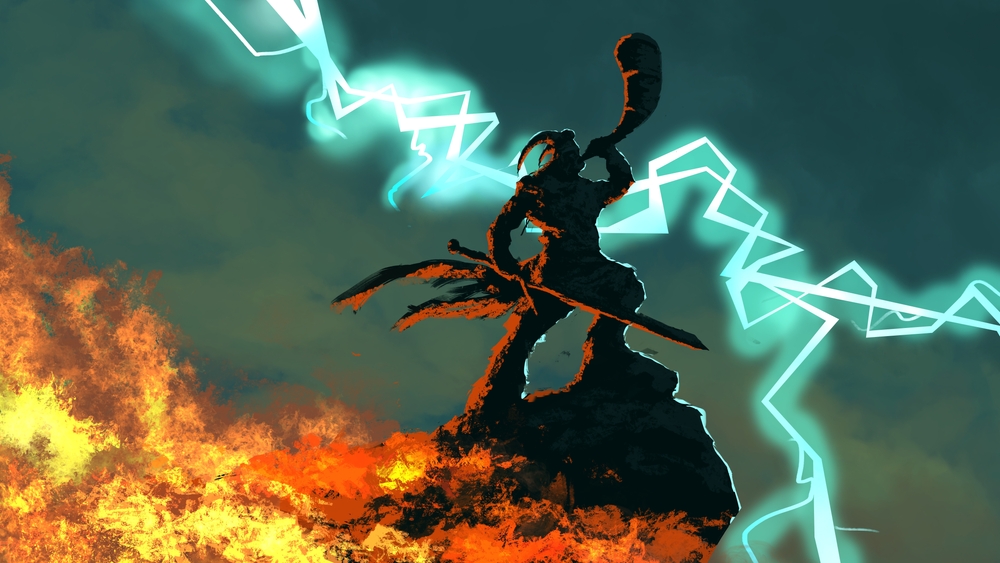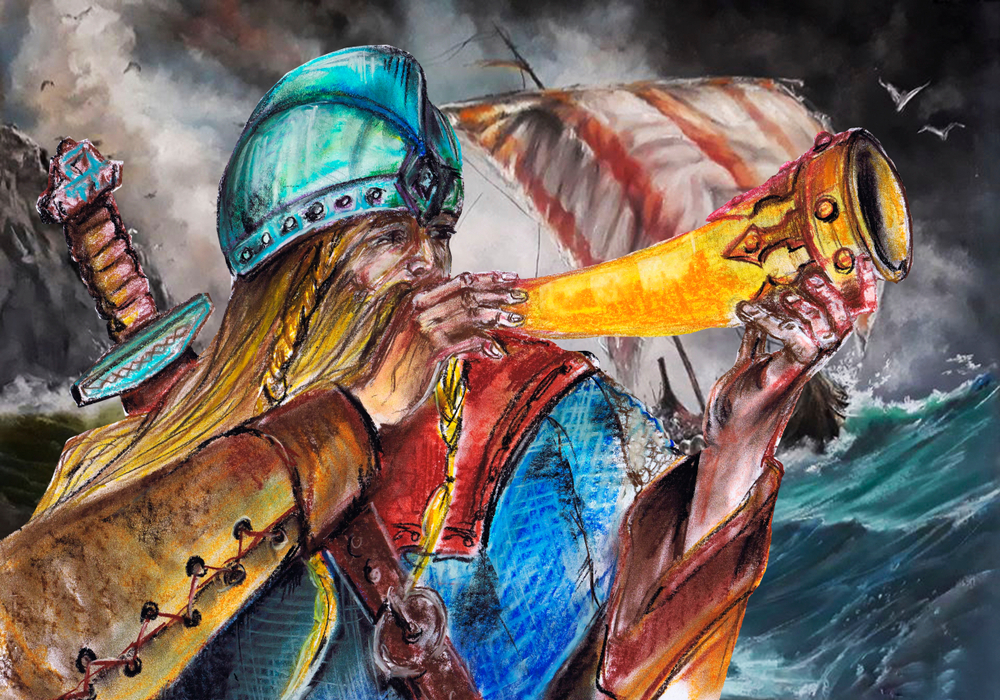While Heimdall is a lesser-known Æsir god, there is little doubt that he plays an important role in Norse mythology. At a glance, his role might seem decidedly less glamorous in a world filled with magic and might. However, he is widely recognised as one of the most important figures in the Norse world, ensuring that the social order of the cosmos is upheld. Although Norse mythology is filled with all-powerful deities - such as the AllFather, Odin, the god of thunder, Thor, and the Norse Goddess, Freya - it is Heimdall who is the gatekeeper of the Bifrost and entrusted with the overall protection of Asgard.

Jump to:
Despite his apparent importance in mythology, the tales of Heimdall are somewhat sparse, especially when compared to other Æsir and Vanir gods, leaving him shrouded in mystery and intrigue. With this element of mystery comes a certain amount of attention and interest. So, let’s unpack and dissect the vigilant Guardian of Asgard and Watchman of the Bifrost.
What is Heimdall The God Of?
As previously alluded to, Heimdall’s role amongst the gods is slightly unique. His role is not encapsulated by a specific domain, such as thunder, mischief or war. Instead, he is famed as the Watchmen of the Gods, exhibiting incredible abilities of foresight, surveillance, order and foreknowledge. Heimdall is often depicted with his trusted horn (named the Gjallarhorn) at hand, standing solemnly atop the Bifrost Bridge. This rainbow bridge connects the world of gods (Asgard) with humanity (Midgard) and is an integral part of the nine realms.
Because of his all-encompassing role, he has been given many titles, including the Guardian of Asgard, Watchman of the Bifrost, Father of Mankind, and many more.
What Were His Powers and Abilities?
Heimdall’s powers and abilities differed slightly from those of other Norse gods. Because he did not have a ‘god of’ designation, his powers are often considered to be more vast and not as easy to define. One of his primary powers is his extremely powerful senses, which allow him to feel the rustling wind in Midgard and hear the elves breathing in far-away Alfheim.
He has the ability of foresight, enabling him to see things that haven’t come to pass: an ability which proves invaluable when considering the ongoing threat of Ragnarok. Not only can he hear wool growing on a sheep and see into the future, but he also requires less sleep than a bird, making him the perfect sentinel for the Æsir gods.
Heimdall has access to the famed Gjallarhorn, a horn that echoes through the nine realms when sounded. It serves as the ultimate alarm and announcer of important moments in the Norse world. In addition to his acute sense and incredible foresight, Heimdall exhibits superhuman strength and Asgardian durability, making him one of the most powerful gods in mythology.
Want to put your knowledge of the Norse pantheon to the test?
Centre of Excellence has you covered.
Visit our Norse Gods and Goddesses Hub to sample the first 2 modules of our £127 Norse Mythology Diploma Course for FREE
Who Are Heimdall's Parents?
The subject of lineage is always an important topic in Norse mythology. However, it can be argued that Heimdall’s parentage is of particular interest. Even in the magical world of Norse mythology, Heimdall’s birth was unprecedented.
Heimdall is the son of the AllFather, Odin: potentially the most powerful of the Asgardian gods. Being a son of Odin highlights Heimdall as one of the most important figures in all of the nine realms. While his father is a prominent figure in Norse mythology, it is arguably his mother (or should we say mothers!) who makes his birth all the more extraordinary. Heimdall is the son of not one, not two, or even three women, but he is said to be the son of nine mothers. His mothers, who are often described as sisters in some sources, are as enigmatic as the vast depths of the sea. Their names are: Angeyja, Atla, Eistla, Gjalp, Greip, Imor, Jarnsaxa, and Ulfrun.
Why Does Heimdall Hate Loki?
The rivalry between Heimdall and Loki is almost as famous as that of Thor and Loki. One of the most common reasons for their hatred is due to their intertwined fates (a topic we will revisit towards the end of this article). Predominantly, Heimdall hates Loki because he is part Jötnar (a member of a group of giants who serve as one of the primary antagonists of the gods) and partly because he can slip in and out of Asgard outside of his watchful eye. Due to Loki’s moniker as the God of Mischief, he certainly came to blows with numerous other gods, but there is no doubt that Heimdall is one of his biggest adversaries.
What Does Heimdall Look Like?
When some people think of Heimdall’s appearance, they probably think of Idris Elba in the Marvel cinematic universe, or of a slightly younger version from the God of War franchise. However, Heimdall in Norse mythology looks vastly different. He is known as the shiniest of the gods because he has the “whitest skin” (quite literally, his skin shone brightly). One of his most distinguishable features is his solid gold teeth, which are often linked to a connection with wealth and prosperity or as a physical manifestation of his divinity. Heimdall is often imagined to have a long grey beard and an instantly recognisable horned helmet.
How Old Was Heimdall?
While deciphering how old gods are in human years can seem like an impossible task, it seems evident that most Asgardians are extremely long-lived beings. As such, it is unsurprising that Heimdall is often cited as being over 1,500 years old.

What Was His Role in Ragnarok?
Ragnarok is, without question the biggest event in the cosmos. It is prophesied to begin with an intense cold spell, the heavens splitting, and the deceased emerging from their resting places. Amid this turmoil, the giants attack Asgard. With his position as protector of the Bifrost, Heimdall plays a pivotal role in this apocalyptic event.
Heimdall blows the Gjallarhorn, alerting the nine realms to their impending doom. This signifies the start of the cataclysmic events of Ragnarok, when the forces of chaos - including the giants and monsters led by his archrival, Loki - march on Asgard.
One of the most dramatic moments of Ragnarok is Heimdall’s direct confrontation with Loki, a moment that’s foretold in the Poetic Edda and the Prose Edda, which are commonly acknowledged as the primary sources for Norse mythology. Heimdall and Loki are destined to kill each other during their confrontation, and this prophecy is fulfilled as the showdown between the two formidable adversaries inevitably results in their deaths.
Learn More About Norse Mythology from the Centre of Excellence
If you are interested in learning more about the expansive and diverse world of Norse mythology, be sure to visit our Norse Gods and Goddesses hub. There, you can access the first two modules of our fantastic Norse mythology diploma course for FREE. There is so much more to learn about Heimdall and the other Norse gods, so why not enrol today?
Want to put your knowledge of the Norse pantheon to the test?
Centre of Excellence has you covered.
Visit our Norse Gods and Goddesses Hub to sample the first 2 modules of our £127 Norse Mythology Diploma Course for FREE





